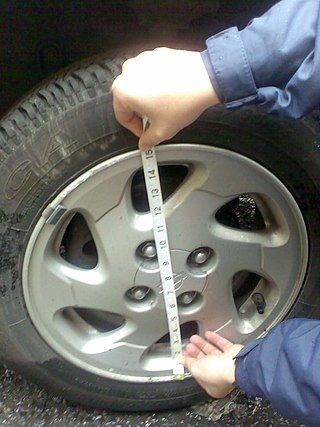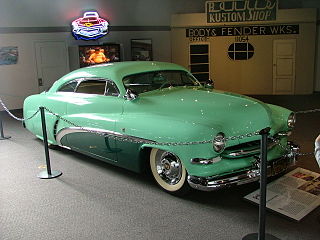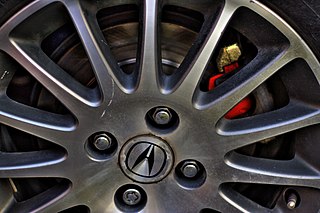
A tire or tyre is a ring-shaped component that surrounds a wheel's rim to transfer a vehicle's load from the axle through the wheel to the ground and to provide traction on the surface over which the wheel travels. Most tires, such as those for automobiles and bicycles, are pneumatically inflated structures, which also provide a flexible cushion that absorbs shock as the tire rolls over rough features on the surface. Tires provide a footprint, called a contact patch, that is designed to match the weight of the vehicle with the bearing strength of the surface that it rolls over by providing a bearing pressure that will not deform the surface excessively.

An axle or axletree is a central shaft for a rotating wheel or gear. On wheeled vehicles, the axle may be fixed to the wheels, rotating with them, or fixed to the vehicle, with the wheels rotating around the axle. In the former case, bearings or bushings are provided at the mounting points where the axle is supported. In the latter case, a bearing or bushing sits inside a central hole in the wheel to allow the wheel or gear to rotate around the axle. Sometimes, especially on bicycles, the latter type of axle is referred to as a spindle.

A hubcap or hub cap is a decorative disk on an automobile wheel that covers at minimum the central portion of the wheel, called the hub. An automobile hubcap is used to cover the wheel hub and the wheel fasteners to reduce the accumulation of dirt and moisture. It also has the function of decorating the car.
There are many types of car body styles. They vary depending on intended use, market position, location, and the era they were made in.

The term custom wheel refers to the wheels of a vehicle which have either been modified from the vehicle manufacturer's standard or have replaced the manufacturer's standard.

The wheel size for a motor vehicle or similar wheel has a number of parameters.

Motobécane was a French manufacturer of bicycles, mopeds, motorcycles, and other small vehicles, established in 1923. "Motobécane" is a compound of "moto", short for motorcycle; "bécane" is slang for "bike."

A wrecking yard, scrapyard or junkyard is the location of a business in dismantling where wrecked or decommissioned vehicles are brought, their usable parts are sold for use in operating vehicles, while the unusable metal parts, known as scrap metal parts, are sold to metal-recycling companies. Other terms include wreck yard, wrecker's yard, salvage yard, breaker's yard, dismantler and scrapheap. In the United Kingdom, car salvage yards are known as car breakers, while motorcycle salvage yards are known as bike breakers. In Australia, they are often referred to as 'Wreckers'.

A custom car is a passenger vehicle that has been either substantially altered to improve its performance, often by altering or replacing the engine and transmission; made into a personal "styling" statement, using paintwork and aftermarket accessories to make the car look unlike any car as delivered from the factory; or some combination of both. A desire among some automotive enthusiasts in the United States is to push "styling and performance a step beyond the showroom floor - to truly craft an automobile of one's own." A custom car in British according to Collins English Dictionary is built to the buyer's own specifications.

The trunk or boot of a car is the vehicle's main storage or cargo compartment, often a hatch at the rear of the vehicle. It can also be called a tailgate.
The spinner on automobile wheels historically refers to knock-off hub nuts or center caps. They may be the actual, or intended to simulate, the design used on antique vehicles or vintage sports cars. A "spinner wheel" in contemporary usage is a type of hubcap or inner wheel ornament, that spins independently inside of a wheel itself when the vehicle is in motion, and continues to spin once the vehicle has come to a stop.

A lug wrench, also colloquially known as a tire iron, is the name for a type of socket wrench used to loosen and tighten lug nuts on automobile wheels. In the United Kingdom and Australia, it is commonly known as a wheel brace.

The rim is the "outer edge of a wheel, holding the tire". It makes up the outer circular design of the wheel on which the inside edge of the tire is mounted on vehicles such as automobiles. For example, on a bicycle wheel the rim is a large hoop attached to the outer ends of the spokes of the wheel that holds the tire and tube. In cross-section, the rim is deep in the center and shallow at the outer edges, thus forming a "U" shape that supports the bead of the tire casing.

A lug nut or wheel nut is a fastener, specifically a nut, used to secure a wheel on a vehicle. Typically, lug nuts are found on automobiles, trucks (lorries), and other large vehicles using rubber tires.

In the automotive industry, alloy wheels are wheels that are made from an alloy of aluminium or magnesium. Alloys are mixtures of a metal and other elements. They generally provide greater strength over pure metals, which are usually much softer and more ductile. Alloys of aluminium or magnesium are typically lighter for the same strength, provide better heat conduction, and often produce improved cosmetic appearance over steel wheels. Although steel, the most common material used in wheel production, is an alloy of iron and carbon, the term "alloy wheel" is usually reserved for wheels made from nonferrous alloys.

A spare tire is an additional tire carried in a motor vehicle as a replacement for one that goes flat, has a blowout, or has another emergency. Spare tire is generally a misnomer, as almost all vehicles actually carry an entire wheel with a tire mounted on it as a spare rather than just a tire, as fitting a tire to a wheel would require a motorist to carry additional, specialized equipment. However, some spare tires are not meant to be driven long distances. Space-savers have a maximum speed of around 50 mph (80 km/h).

A vehicle frame, also historically known as its chassis, is the main supporting structure of a motor vehicle to which all other components are attached, comparable to the skeleton of an organism.

A loose wheel nut indicator is a measuring tool that warns of loose wheel nuts, which is the most common cause of wheels on vehicles falling off.
A centerlock wheel is a type of automobile wheel in which the wheel is fastened to the axle using a single, central nut, instead of the more common ring of 4 or 5 lug nuts or bolts.

Wheel spikes are pointy protrusions attached to the rims or hubcaps of vehicles, most commonly cars and semi trucks. Most wheel spikes sold are made out of plastic painted to mimic metal, and are meant mostly as novelty items. The safety and legality of wheel spikes has been often questioned, and they may constitute a traffic violation in some jurisdictions.
















